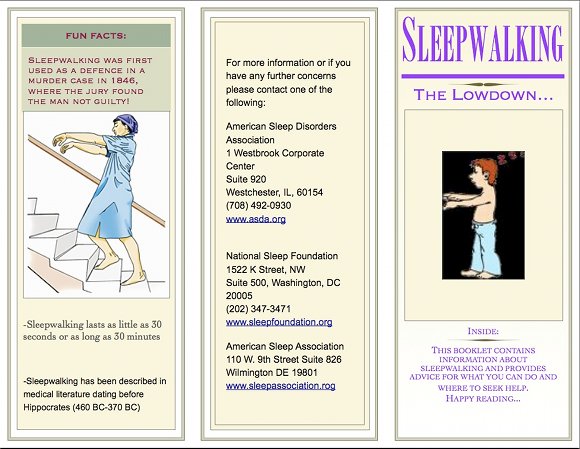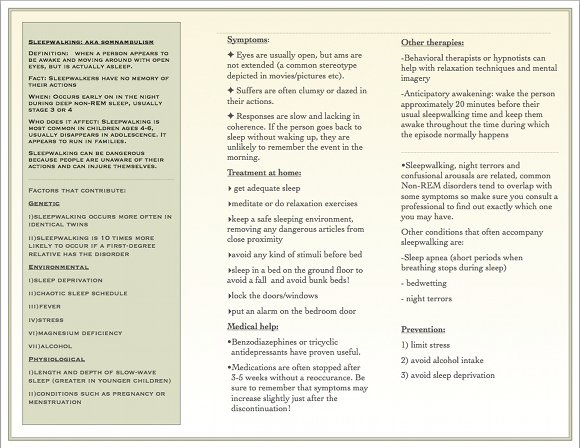
| Connect & Subscribe |
Sleepwalking Brochure: The Lowdown....
An Outreach Project by Ebony Mia Smallman | Return To Outreach Projects 2010
The following is a brochure created for Stanford Sleep and Dreams. If it is difficult to read using the images, you may view the text here.
Also feel free to download this brochure for distributional or general information purposes. Please refer to our privacy policy for our relevant disclaimers.


Fun Facts:
Sleepwalking was first used as a defence in a murder case in 1846, where the jury found the man not guilty!
Sleepwalking lasts as little as 30 seconds or as long as 30 minutes
Sleepwalking has been described in medical literature dating before Hippocrates (460 BC-370 BC)
Sleepwalking: aka Somnambulism
Definition: when a person appears to be awake and moving around with open eyes, but is actually asleep.
Fact: Sleepwalkers have no memory of their actions
When: Occurs early on in the night during deep non-REM sleep, usually stage 3 or 4.
Who does it affect: Sleepwalking is most common in children ages 4-6, usually disappears in adolescence. It appears to run in families.
Sleepwalking can be dangerous because people are unaware of their actions and can injure themselves.
Factors that Contribute
Genetic
i)sleepwalking occurs more often in identical twins
ii)sleepwalking is 10 times more likely to occur if a first-degree relative has the disorder
Environmental
i)sleep deprivation
ii)chaotic sleep schedule
iii)fever
iv)stress
vi)magnesium deficiency
vii)alcohol
Physiological
i)length and depth of slow-wave sleep (greater in younger children)
ii)conditions such as pregnancy or menstruation
Symptoms
Treatment at Home
get adequate sleep
meditate or do relaxation exercises
keep a safe sleeping environment, removing any dangerous articles from close proximity
avoid any kind of stimuli before bed
sleep in a bed on the ground floor to avoid a fall and avoid bunk beds!
lock the doors/windows
put an alarm on the bedroom door
Medical Help
-Benzodiazephines or tricyclic antidepressants have proven useful.
-Medications are often stopped after 3-5 weeks without a reoccurance. Be sure to remember that symptoms may increase slightly just after the discontinuation!
Other therapies:
-Behavioral therapists or hypnotists can help with relaxation techniques and mental imagery
-Anticipatory awakening: wake the person approximately 20 minutes before their usual sleepwalking time and keep them awake throughout the time during which the episode normally happens
Sleepwalking, night terrors and confusional arousals are related, common Non-REM disorders tend to overlap with some symptoms so make sure you consult a professional to find out exactly which one you may have.
Other conditions that often accompany sleepwalking are:
-Sleep apnea (short periods when breathing stops during sleep)
- bedwetting
- night terrors
Prevention
1) limit stress
2) avoid alcohol intake
3) avoid sleep deprivation
For more information or if you have any further concerns please contact one of the following:
American Sleep Disorders Association
1 Westbrook Corporate Center
Suite 920
Westchester, IL, 60154
(708) 492-0930
www.asda.org
National Sleep Foundation
1522 K Street, NW
Suite 500, Washington, DC 20005
(202) 347-3471
www.sleepfoundation.org
American Sleep Association
110 W. 9th Street Suite 826
Wilmington DE 19801
www.sleepassociation.rog
About This Site
Welcome! This site is continuously being created by students of Dr. William C. Dement's Sleep And Dreams course at Stanford University.
We made this site as a call to action for people all over the world to live healthier, happier, safer, and more productive lives by learning about their own sleep. We have faith that reading the information provided on this site will motivate you to be smart about your sleep deprivation and strategic about your alertness in order to live life to your fullest, most energetic potential.
In fact, we challenge you to do so! What do you say, are you up for the challenge?
Interviews With Sleep Specialists: Insights Into the Worlds of Sleep Medicine & Sleep Business
America's Most Dangerous Disorder: What Is Sleep Apnea Doing To Your Sleep?
Sleep Debt: How Much More Will You Achieve When You Reduce Yours?
The Stages Of Sleep: The Journey Through The Night
Delayed Sleep Phase: You Want To Sleep But You're Not Tired Yet
Paralyzed at Night: Is Sleep Paralysis Normal?
Sleep In Words: Smart, Strange, and Funny Quotes About Sleep
Sleep Disorders In Children: What's Keeping Your Child From A Full Night's Rest?
Attacks of Pavor Nocturnus (a.k.a. Sleep Terrors, Night Terrors, or Incubus Attacks)
The Stanford Sleep Book
Dr. Dement's pioneering textbook has been the core text for Sleep and Dreams since 1980, but it has just recently been made available to the wider public for the first time.
In it you'll find a more detailed account of the most important things you need to know about sleep, alertness, dreams, and sleep disorders. Studies, statistics, plus plenty of Dr. Dement's classic anecdotes painting the history of sleep medicine.
Preface | Intro | Contents | Get A Copy
More Sleep Resources
The Zeo
A revolution in personal sleep tracking, the Zeo is a wireless headband that transmits your brainwaves in realtime to a dock (pictured here) or your smartphone. The result? You can wake up and see exactly what stages of sleep you were in during the night! Unprecedented personalized sleep knowledge.
Sleep Paralysis: A Dreamer's Guide
Ever woken up paralyzed? A surprising number of us have, believe it or not. But few know the actual causes of this phenomenon, and fewer still how to exert control over it. Dream researcher and sleep paralysis expert Ryan Hurd shares breakthrough insights into how to do just that.
Important Disclaimer
Please Note:
The information found on this page and throughout this site is intended for general information purposes only. While it may prove useful and empowering, it is NOT intended as a substitute for the expertise and judgments of healthcare practitioners.
For more info, see our
Terms of Use.









